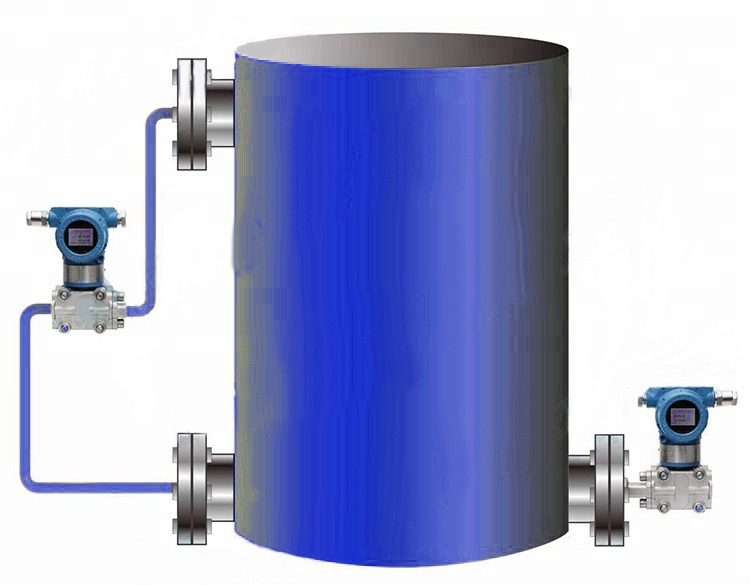What Is Hydrostatic Pressure?
Hydrostatic pressure is the pressure that a homogeneous fluid acts on an object.
This is a omnidirectional force that is evenly applied to all parts of the surface of the object. Increased hydrostatic pressure will reduce the volume of the stressed object, but will not change its shape
What is Hydrostatic pressure sensor?
Hydrostatic pressure sensors are used to measure the level or fill height of liquids. Hydrostatic pressure measurement is suitable for liquid level measurement due to the static pressure effect of non-flowing fluids. This physical principle describes the effect of the gravity of a stationary (i.e. non-flowing) liquid on the measurement point. This gravity is often described as “hydrostatic pressure”.

How is hydrostatic pressure measured ?
A submersible pressure transducer or a flush pressure sensor measures the height-dependent weight-force of the liquid column, also known as hydrostatic pressure.
This pressure measurement is directly proportional to the liquid level respectively liquid column, at the measuring point of the pressure sensor. It is, therefore, necessary, for the measurement of level, that the pressure sensor is placed as close as possible to the level of the vessel’s bottom.
The measured hydrostatic pressure then directly corresponds to the height of the liquid column, from the ground-level measurement point to the surface-level of the medium.
So, the filling height is calculated from the distance of the medium surface, to the measuring point by the pressure measurement.
The weight force of the liquid column, thus the hydrostatic pressure, however, is not only directly proportional to the filling height but also varies with the specific gravity of the medium and the force of gravity.
How to measure pressure by using a level sensor ?
Usually we measure the liquid level by measuring the pressure.
When the liquid level transmitter is put into a certain depth in the measured liquid, the pressure formula of the sensor facing the liquid surface is: Ρ = ρ.g.H + Po. In the formula:
P: the pressure on the liquid face of the transmitter
Ρ: measured liquid density
G: local gravity acceleration
Po: atmospheric pressure on the liquid surface
H: Depth of transmitter into liquid
At the same time, the pressure of the liquid is introduced into the positive pressure chamber of the sensor through the air-conducting stainless steel. Then connect the atmospheric pressure Po on the liquid surface to the negative pressure chamber of the sensor. To offset Po on the back of the sensor, the pressure measured by the sensor is: ρ.g.H. Obviously, by measuring the pressure P, the liquid level depth can be obtained.
Of course, if the liquid level is measured, the pressure value can also be converted.
HYDROSTATIC LEVEL MEASUREMENT WITH PRESSURE TRANSMITTER
Hydrostatic level measurement is often used for tank level measurement. Hydrostatic level measurement is one type of continuous level measurement.

In open and closed tanks, there may be special conditions such as high temperature and corrosion. At this time, use a pressure or differential pressure transmitter, with flange, diaphragm, capillary, etc. We can achieve the static pressure measurement of the tank liquid level.
What is Hydrostatic level transmitter?
Hydrostatic level transmitter is actually a type of pressure transmitter. Hydrostatic level transmitter is the application of pressure transmitter to liquid level measurement. The submersible Hydostatic pressure level transmitter is based on the principle that the measured liquid static pressure is proportional to the height of the liquid. Piezoresistive effect using diffused silicon or ceramic sensitive elements. Convert static pressure into electrical signal. After temperature compensation and linear correction. Convert to 4-20mADC standard current signal output. In order to achieve liquid level measurement.
HYDROSTATIC LEVEL SENSOR INSTALLATION GUIDE
1.If you choose a submersible pressure transmitter. You must lower the device into the medium by cable. Until you reach the bottom of the tank, reservoir or underground resources, or until you reach the required zero level. Then, run the cable from the oil tank or water tank to the control system. Connect the level probe to the PLC accordingly.
2.If you have turbulent media, you should use an extra tank weight to stabilize the level probe in the media. To obtain a stable pressure reading. To prevent the cable from any mechanical damage. You can use the cable clamp to fix the cable on the top of the water tank. Or when connecting the cable to the control system.
3.If you choose a standard pressure transmitter. Simply screw the transmitter into the threaded hole on the bottom or side of the tank. Then, connect the transmitter to the PLC with the appropriate cable connector. Or if cable connection is selected, connect the transmitter directly to the control system.












